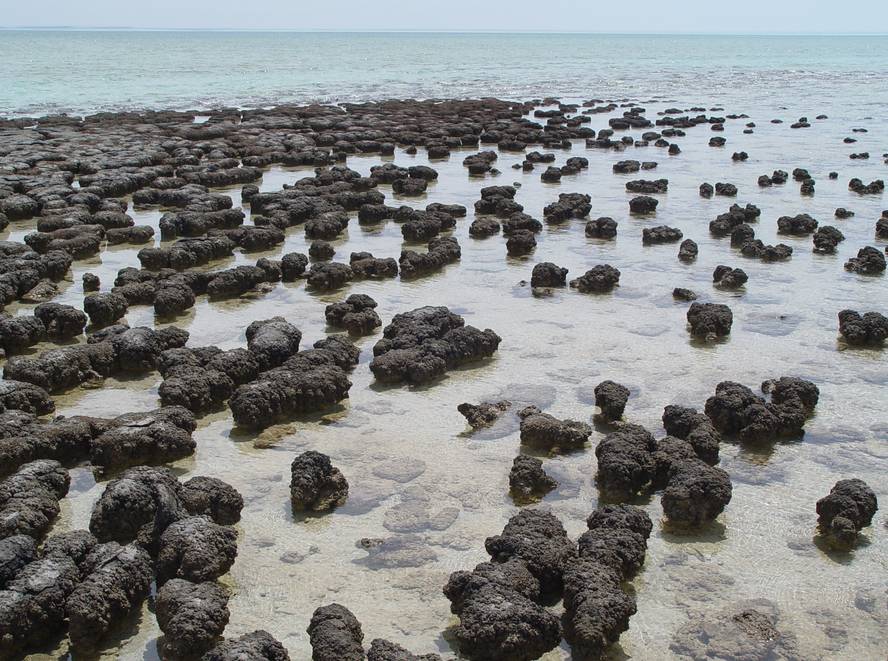Cyanobacteria: first transformers
The atmosphere that surrounds our planet does not resemble much that it initially had. The first atmosphere was similar to that of some of Jupiter's moons, which replaced oxygen and nitrogen with hydrogen, helium, carbon dioxide, methane, nitrogen and nitrogen. Therefore, it was very unstable and totally toxic to current life. However, about 3,600 million years ago the first cyanobacteria emerged and transformed the planet, releasing oxygen to the atmosphere and changing the world.
There are still remains of those first transformers, the estromatolites. The paleontologist Xabier Murelaga Bereikua explained that cyanobacteria were the first oxygen producers: “They were the first photosynthetic experiences. Through photosynthesis, hydrogen was extracted from the water and oxygen was released into the atmosphere. At the same time, the carbonated particles were consolidated, giving rise to a series of unique geological formations, the stromatolites. In some places, these structures can be seen today.”
Murelaga has highlighted the direct influence of cyanobacteria in the current atmosphere and, therefore, in life: “To them we owe the aerobic atmosphere we have and the ozone layer that protects us from ultraviolet rays. On the other hand, as cyanobacteria proliferate and are enriched in the oxygen atmosphere, the anaerobic living beings resorted to protected corners, but most were destroyed.”
Murelaga recalls that the oxygen produced by cyanobacteria also had indirect effects, setting as an example the banded iron formations: “This oxidizing atmosphere caused the formation of rocks formed by layers of iron, the banded iron formations. In fact, in those times volcanic activity was intense and the emissions of iron into the atmosphere were high. In an environment without oxygen, iron is soluble in water, so the oceans were very rich in iron. But when the atmosphere became oxidizing, 2,400 to 1,900 million years ago, dissolved iron was oxidized and these special deposits were formed. These are the largest iron deposits in the world.”
Mass destruction
According to Murelaga, to date there has been no other phenomenon that can be assimilated to the change caused by cyanobacteria. However, despite not being its size, there have been some remarkable milestones, such as mass extinctions.
Mass extinctions represent the sudden disappearance of many species. They have been produced in specific moments of geological history, so they coincide with the main limits of the geological scale. Thus, according to most scientists, there have been five mass destructions in the last 542 million years of Earth: In the Upper Ordovician, Upper Devonic, Permo-Triassic, Triassic/Jurassic Muga and Upper Cretaceous.
The largest was that of Permo-Triassic, which mainly affected marine invertebrates. However, the best known is what happened during the Cretaceous/Tertiary transition, when the dinosaurs disappeared along with many other groups of animals. According to the general hypothesis, this destruction was largely caused by the impact of a large asteroid, but it is not clear to what extent other factors such as climate change and massive volcanic eruptions influenced.
In the rest of the mass extinctions also appear factors such as the change of solar radiation, the investment of the earth's magnetic field, the supernovae, the changes in the composition of the atmosphere or the oceans, the rise or fall of the sea level... But in most cases there is no clear evidence.
In any case, Murelaga warns that, although mass destruction led to great ecological changes, they have not transformed the planet itself. And so he has manifested it once again: “I think that until we arrive we have not produced a change equivalent to that caused by cyanobacteria.”
Cyanobacteria, today
After changing the world, cyanobacteria have managed to adapt to the conditions of all time and have remained until today. They live in shallow waters, where the light of the Sun reaches them and at a pH higher than 5. As carbonates precipitate, stromatolites are formed, around which other bacteria grow. Thus, at the bottom of the stromatolites colonies of anaerobic bacteria are formed, while cyanobacterias are located at the top.
This ecosystem is very vulnerable and several researchers have warned that it is threatened by climate change. For example, researchers at the University of Oregon have shown that the eutrophication of water directly influences the balance of cyanobacteria.
According to the researchers, Microcystis sp. Cyanobacteria have increased too much due to eutrophication. In fact, these cyanobacterias are typical of hardened ponds with a lot of nutrients, and are somewhat toxic. When they grow too much, however, toxicity increases considerably and eliminate other cyanobacteria. Not only cyanobacteria, but they also make water toxic for other species, including for us.
This is the third entry of Scientific Culture. Participates in the festival




_display.JPG)



